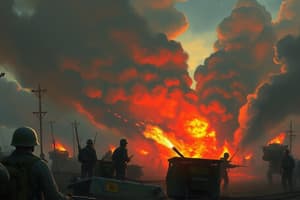Podcast
Questions and Answers
What was one significant consequence of the military buildup during the Cold War?
What was one significant consequence of the military buildup during the Cold War?
- Improved global cooperation on education
- Neglect of human development aspects (correct)
- Resolution of poverty worldwide
- Enhanced space exploration for peaceful purposes
What primarily led to the collapse of the Soviet Union at the end of the Cold War?
What primarily led to the collapse of the Soviet Union at the end of the Cold War?
- A decisive military defeat by the United States
- An international treaty that disbanded the Soviet forces
- Significant economic pressures and political upheavals (correct)
- Increased public support for Western ideology
What event symbolized the end of the Cold War structure in 1989?
What event symbolized the end of the Cold War structure in 1989?
- The signing of the Non-Proliferation Treaty
- The establishment of NATO
- The fall of the Berlin Wall (correct)
- The launch of the first spacecraft
Despite the end of the Cold War, which of the following issues continued to cause tensions globally?
Despite the end of the Cold War, which of the following issues continued to cause tensions globally?
How did the Cold War affect the United States by the end of the conflict?
How did the Cold War affect the United States by the end of the conflict?
What did the military buildup during the Cold War primarily serve as a means to achieve?
What did the military buildup during the Cold War primarily serve as a means to achieve?
What was a notable consequence of the Soviet Union's focus on military strength?
What was a notable consequence of the Soviet Union's focus on military strength?
What characterized the relationship between the US and USSR by the end of the Cold War?
What characterized the relationship between the US and USSR by the end of the Cold War?
What event marked the symbolic collapse of the Cold War structure?
What event marked the symbolic collapse of the Cold War structure?
Why did tensions persist globally after the Cold War ended?
Why did tensions persist globally after the Cold War ended?
Flashcards are hidden until you start studying
Study Notes
Wasted Resources
- Both the US and USSR invested trillions in military enhancements, including weapons, nuclear arms, and space endeavors to establish dominance.
- Potentially valuable resources could have been redirected to tackle critical domestic and global challenges, such as poverty alleviation, infrastructural development, educational improvement, and healthcare advancement.
The Soviet Union's Focus on Military Prowess
- The emphasis on military power resulted in neglecting key areas of human development.
- The Soviet Union experienced significant economic stagnation as a consequence of prioritizing arms accumulation over economic growth.
No Tangible Gains
- The end of the Cold War found both superpowers drained economically, politically, and socially.
- The collapse of the Soviet Union was not due to outright military defeat but arose from severe internal economic stresses and political turmoil.
- Although the United States emerged as the leading superpower post-Cold War, it grappled with internal divisions and challenges linked to prolonged Cold War strategies.
- The fall of the Berlin Wall in 1989 and the USSR's dissolution in 1991 marked the end of the Cold War framework without a definitive "winner."
The Continuation of Conflict Patterns
- Post-Cold War, lingering tensions continued in various manifestations.
- Ongoing global conflicts, exemplified by strife in the Middle East, cyber warfare, and economic rivalries, indicate that the end of the Cold War did not resolve underlying global discord.
Wasted Resources
- Both the US and USSR invested trillions in military enhancements, including weapons, nuclear arms, and space endeavors to establish dominance.
- Potentially valuable resources could have been redirected to tackle critical domestic and global challenges, such as poverty alleviation, infrastructural development, educational improvement, and healthcare advancement.
The Soviet Union's Focus on Military Prowess
- The emphasis on military power resulted in neglecting key areas of human development.
- The Soviet Union experienced significant economic stagnation as a consequence of prioritizing arms accumulation over economic growth.
No Tangible Gains
- The end of the Cold War found both superpowers drained economically, politically, and socially.
- The collapse of the Soviet Union was not due to outright military defeat but arose from severe internal economic stresses and political turmoil.
- Although the United States emerged as the leading superpower post-Cold War, it grappled with internal divisions and challenges linked to prolonged Cold War strategies.
- The fall of the Berlin Wall in 1989 and the USSR's dissolution in 1991 marked the end of the Cold War framework without a definitive "winner."
The Continuation of Conflict Patterns
- Post-Cold War, lingering tensions continued in various manifestations.
- Ongoing global conflicts, exemplified by strife in the Middle East, cyber warfare, and economic rivalries, indicate that the end of the Cold War did not resolve underlying global discord.
Studying That Suits You
Use AI to generate personalized quizzes and flashcards to suit your learning preferences.




